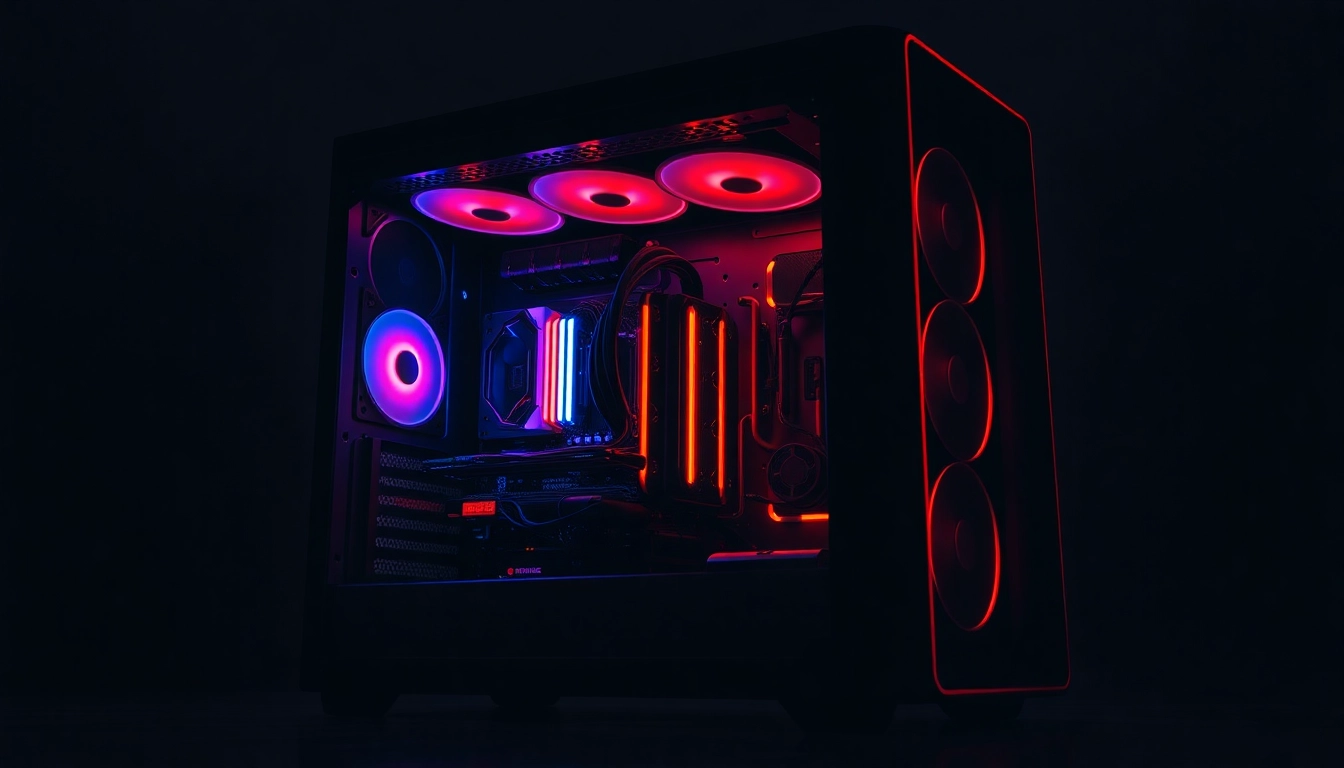Understanding Thermal Management Materials
Definition and Importance
Thermal management materials are specialized substances designed to control the temperature within electronic devices, ensuring optimal performance and reliability. As modern electronics become increasingly compact and powerful, effectively managing heat is essential not only for performance but also for the longevity of devices. Poor thermal management can lead to overheating, which can degrade or damage sensitive components, significantly reducing a device’s lifespan or causing total failure. Products categorized under thermal management materials play a pivotal role in heat dissipation, aiding in the efficient operation of electronic devices. These materials are employed in various applications ranging from consumer electronics to industrial solutions.
Incorporating thermal management materials into designs is not just a technical choice; it is a cornerstone for creating sustainable electronic products that comply with industry regulations and customer expectations.
Types of Thermal Management Materials
Thermal management materials can be classified into several categories based on their material properties, functions, and applications:
- Thermal Interface Materials (TIMs): These materials enhance thermal conductivity between two surfaces, typically between a component and a heat sink. Types of TIMs include thermal pastes, pads, and adhesives.
- Phase Change Materials (PCMs): These materials absorb, store, and release thermal energy as they change from solid to liquid and vice versa. They are effective in applications requiring stable thermal management across various temperature ranges.
- Thermal Gap Fillers: These materials fill air gaps and enhance heat transfer where direct contact is not possible. Common examples include silicone and urethane-based compounds.
- Thermal Conductive Adhesives: These adhesives bond components together while also facilitating heat flow, making them useful in assembly processes that require both adhesion and thermal management.
- Heat Spreaders: Typically made from metals like copper or aluminum, these materials distribute heat away from critical components to prevent localized overheating.
Applications in Electronics
Thermal management materials are utilized across a broad spectrum of electronic applications:
- Consumer Electronics: In smartphones, tablets, and laptops, thermal management materials help dissipate heat generated by CPUs and GPUs, enhancing performance while preventing thermal throttling.
- Automotive Electronics: Modern vehicles employ numerous electronic systems that generate heat. Thermal management materials ensure that components like batteries and microcontrollers operate efficiently and safely.
- Telecommunications: Base stations and network components require efficient heat dissipation to maintain operational reliability, especially in diverse environmental conditions.
- Industrial Equipment: Heavy machinery and industrial automation equipment utilize thermal management solutions to ensure the durability of controllers and sensors under high-stress conditions.
Key Features of Effective Thermal Management Materials
Thermal Conductivity Metrics
The primary feature of any thermal management material is its thermal conductivity, often quantified in watts per meter-kelvin (W/mK). High thermal conductivity ratings indicate better heat dissipation capabilities. Efficient materials should ideally possess characteristics like:
- Low Thermal Resistance: This is crucial for minimizing the thermal interface resistance, enhancing the heat transfer between components.
- High Power Handling Capacity: To ensure that the materials can effectively manage heat under maximum load conditions without degrading.
Durability and Manufacturing Considerations
Durability is another essential element when selecting thermal management materials. Materials should withstand environmental factors such as temperature fluctuations, humidity, and mechanical stress. Manufacturing considerations involve:
- Compatibility with Surface Treatments: Ensuring that the chosen thermal management material adheres well to the surfaces of the components.
- Processing Techniques: Materials must be adaptable to various manufacturing processes including die cutting, molding, or extruding.
Environmental Impact and Sustainability
With growing environmental concerns, the sustainability of thermal management materials is more critical than ever. Manufacturers are increasingly focusing on developing eco-friendly products through:
- Use of Non-toxic Materials: Ensuring that the thermal management materials do not contain harmful substances which can affect user safety and environmental quality.
- Recyclability: Selecting or designing materials that can be recycled at the end of their lifecycle contributes to reducing waste.
Common Challenges in Thermal Management
Identifying Heat Dissipation Issues
One of the significant challenges in thermal management is accurately identifying heat dissipation issues. Engineers and designers often face difficulties due to:
- Complex Geometries: The intricate designs of modern electronic devices can complicate thermal routing and heat distribution.
- Thermal Simulation Limitations: Many simulations do not account for real-world conditions such as airflow and other thermal paths which can lead to inaccuracies.
Material Selection Challenges
Choosing the right material for thermal management tasks can be daunting due to:
- Cost vs. Performance: High-performance materials often command a significant price, leading to potential trade-offs between budget constraints and thermal efficiency.
- Availability of Advanced Materials: Not all manufacturers have access to cutting-edge thermal materials, affecting the options available to engineers.
Performance Evaluation and Optimization
Once materials are selected and implemented, evaluating their performance is crucial to ensure they meet the desired specifications. Key challenges here include:
- In-Situ Testing: Finding effective ways to measure temperature and heat flux during actual operational conditions can be challenging.
- Iterative Improvement: Achieving continuous improvement in thermal management often requires multiple iterations, which may not always be feasible within tight development timelines.
Best Practices for Implementing Thermal Management Solutions
Material Placement Strategies
One of the effective practices for implementing thermal management solutions is careful material placement. Spatial arrangement can significantly influence heat flow and distribution:
- Layering Techniques: Utilizing multi-layer configurations can enhance heat dissipation in critical areas, especially in densely packed circuit boards.
- Direct Contact: Aiming for direct contact between heat-generating components and heat sinks to minimize thermal interfaces.
Integrating with Electronic Designs
Seamlessly integrating thermal management materials into electronic designs requires a collaborative approach:
- Cross-Disciplinary Collaboration: Engineers from thermal, mechanical, and electrical disciplines should collaborate early in the design process to address potential thermal issues.
- Prototyping: Developing prototypes can help identify thermal challenges and solutions before full-scale production begins.
Measuring Effectiveness Post-Implementation
To ensure the thermal management solutions implemented are effective, proper measurement is critical:
- Thermal Imaging: Utilizing infrared thermography to visualize temperature distributions and identify hotspots during device operation.
- Performance Benchmarking: Regular assessments against industry standards to ensure compliance and identify areas for improvement.
Future Trends in Thermal Management Materials
Advancements in Material Engineering
The future of thermal management materials is being shaped by continuous advancements in material engineering. Innovations like:
- Graphene and Nanomaterials: These materials offer exceptional thermal conductivity while potentially reducing weight and size.
- Self-healing Materials: Ideal for electronics, these materials can repair themselves after sustaining damage, enhancing durability and lifespan.
Emerging Technologies in Thermal Solutions
As thermal management challenges become increasingly complex, emerging technologies will play key roles, including:
- Active Thermal Management Systems: Systems equipped with sensors and control algorithms that adjust cooling methods in real-time for optimized performance.
- Advanced Simulation Tools: Improved predictive tools that allow for better modeling of thermal dynamics in complex environments.
Market Outlook for Thermal Management Materials
The market for thermal management materials is expected to witness significant growth, driven by technological advancements and the need for higher efficiency across industries:
- Increased Demand in Electric Vehicles: As electric vehicles proliferate, the need for efficient battery cooling systems will boost the demand for sophisticated thermal materials.
- Regulatory Push for Energy Efficiency: Increased regulations focusing on energy efficiency will drive the adoption of advanced thermal management solutions in various sectors.



